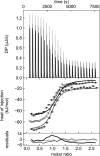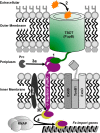Structural basis of cell-surface signaling by a conserved sigma regulator in Gram-negative bacteria
- PMID: 32107313
- PMCID: PMC7186176
- DOI: 10.1074/jbc.RA119.010697
Structural basis of cell-surface signaling by a conserved sigma regulator in Gram-negative bacteria
Abstract
Cell-surface signaling (CSS) in Gram-negative bacteria involves highly conserved regulatory pathways that optimize gene expression by transducing extracellular environmental signals to the cytoplasm via inner-membrane sigma regulators. The molecular details of ferric siderophore-mediated activation of the iron import machinery through a sigma regulator are unclear. Here, we present the 1.56 Å resolution structure of the periplasmic complex of the C-terminal CSS domain (CCSSD) of PupR, the sigma regulator in the Pseudomonas capeferrum pseudobactin BN7/8 transport system, and the N-terminal signaling domain (NTSD) of PupB, an outer-membrane TonB-dependent transducer. The structure revealed that the CCSSD consists of two subdomains: a juxta-membrane subdomain, which has a novel all-β-fold, followed by a secretin/TonB, short N-terminal subdomain at the C terminus of the CCSSD, a previously unobserved topological arrangement of this domain. Using affinity pulldown assays, isothermal titration calorimetry, and thermal denaturation CD spectroscopy, we show that both subdomains are required for binding the NTSD with micromolar affinity and that NTSD binding improves CCSSD stability. Our findings prompt us to present a revised model of CSS wherein the CCSSD:NTSD complex forms prior to ferric-siderophore binding. Upon siderophore binding, conformational changes in the CCSSD enable regulated intramembrane proteolysis of the sigma regulator, ultimately resulting in transcriptional regulation.
Keywords: TonB-dependent transducer; X-ray crystallography; X-ray scattering; bacterial signal transduction; biophysics; cell surface signaling; inner membrane sigma regulator; metal homeostasis; protein structure; structural biology.
© 2020 Jensen et al.
Conflict of interest statement
The authors declare that they have no conflicts of interest with the contents of this article
Figures








References
-
- Jensen J. L., Balbo A., Neau D. B., Chakravarthy S., Zhao H., Sinha S. C., and Colbert C. L. (2015) Mechanistic implications of the unique structural features and dimerization of the cytoplasmic domain of the Pseudomonas sigma regulator, PupR. Biochemistry 54, 5867–5877 10.1021/acs.biochem.5b00826 - DOI - PMC - PubMed
-
- Edgar R. J., Xu X., Shirley M., Konings A. F., Martin L. W., Ackerley D. F., and Lamont I. L. (2014) Interactions between an anti-sigma protein and two sigma factors that regulate the pyoverdine signaling pathway in Pseudomonas aeruginosa. BMC Microbiol. 14, 287 10.1186/s12866-014-0287-2 - DOI - PMC - PubMed
Publication types
MeSH terms
Substances
Supplementary concepts
Associated data
- Actions
- Actions
Grants and funding
LinkOut - more resources
Full Text Sources

